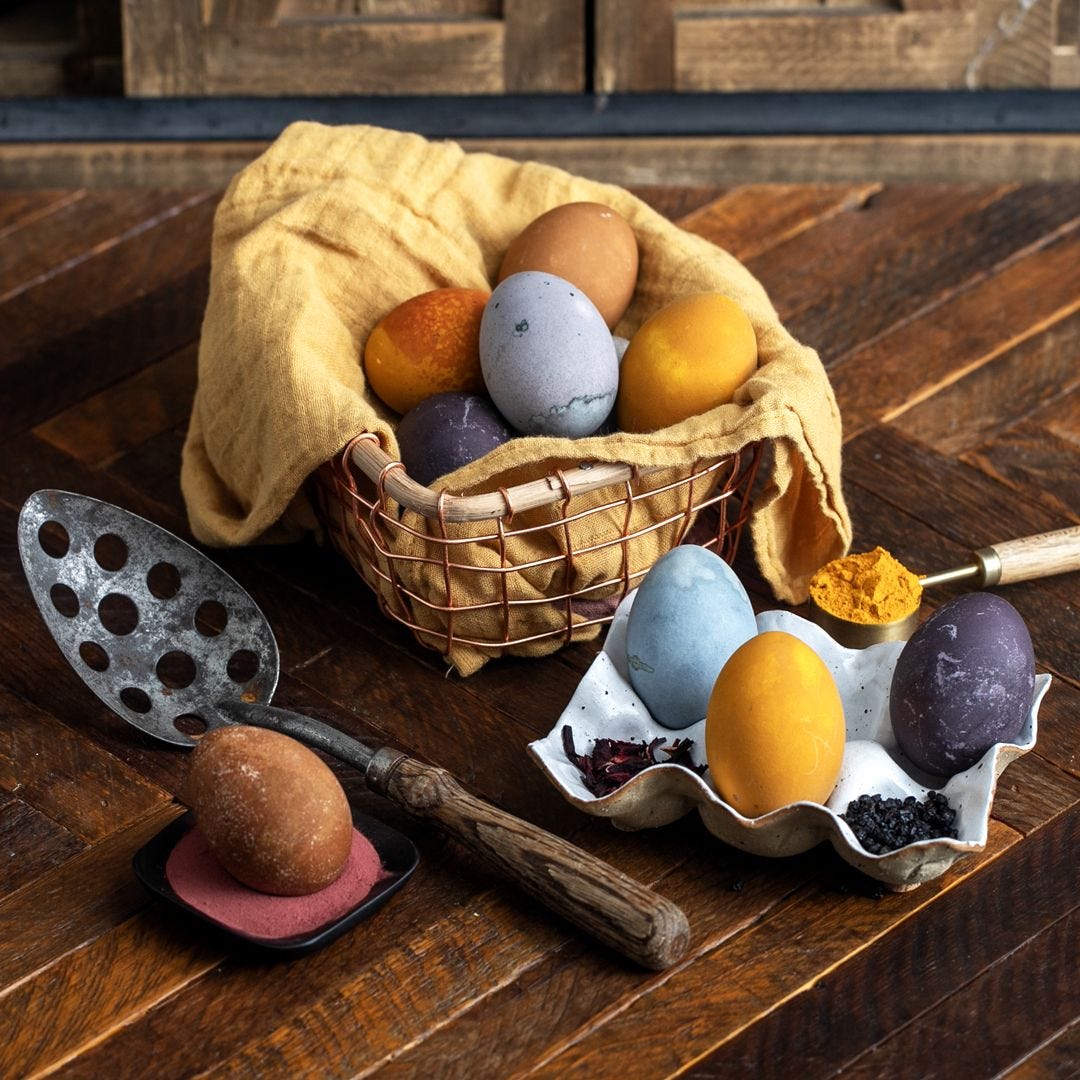If you're decorating eggs in celebration this Easter, engage nature in the process this year and avoid synthetic dyes. Ingredients like herbs and spices offer an endless variety of hues for dyeing eggs -- from the soft purple shades of hibiscus to the rich gold tones of turmeric.
There are two easy ways to dye eggs with botanical-based dyes. One is a hot method, which delivers the deepest colors; the other is cold. You might try each, or use them in combination.


WHAT YOU WILL NEED TO GET STARTED
- Mordant: Alum, cream of tartar, or white vinegar will help the colors penetrate the eggshell. (Mordants aren't necessary, but you'll get better results if you use one. Include one tablespoon of mordant for each cup of water, and add it along with your herbs or other dyeing materials.)
- Pots: Enamel or glass pots (not aluminum) are best.
- Water: Use distilled water or water that is chlorine-filtered.
- Eggs: White eggs will display the subtle, natural colors better than brown or green eggs.
- Dyestuff: The more eggs you're dyeing, the more dyestuff you'll need.
Have fun experimenting with herbs and spices to see what colors they impart, but here are some suggestions to get you started:
BOTANICAL COLORS
- Reddish blue/lavender: Hibiscus flowers
- Deep gold: Turmeric root powder
- Pale yellow: Safflower petals
- Pale orange: Curry powder
- Reddish brown: Chili powder
- Orange: Paprika
- Soft brown: Dill seed
- Tannish yellow: Yarrow
Other egg dye products from plants that make lovely colors:
Beet juice or beet powder, berries, coffee, grape and cranberry juices, lemon and orange peels, red cabbage leaves, tea, onion skins (red and yellow).
INGREDIENTS
Once you get the hang of dyeing eggs this way, you'll work in panfuls and handfuls — but here are some guidelines you can start with:
- 4 cups water
- Dyestuff (about 2 to 4 tablespoons of ground herbs and spices or 1 cup whole or cut and sifted)
- 1 tablespoon mordant (see above)
- 4 to 6 eggs, washed to remove any coating (use raw for hot bath, hard-boiled for cold)
HOT BATH DIRECTIONS
- Bring water, dyestuff, and mordant to a boil.
- Add eggs and reduce heat to a simmer.
- Cook for about 15 minutes, remove from heat, cover and let sit another 15 minutes or more, until desired color.
(The longer you leave the eggs in the dye, the deeper the color.) Remove eggs, gently rinse in lukewarm water, and let air dry.
COLD BATH DIRECTIONS
- Make a dye bath by bringing water, dyestuff and mordant to a boil.
- Simmer the dyestuff until the water is deeply colored, anywhere from half an hour to a couple of hours. (Put a lid on the pot to prevent evaporation.)
- Strain the liquid and cool. Add hard-boiled eggs to the dye, and let soak until desired color is reached — even overnight, in the refrigerator, if you like.
EGG DYEING TIPS AND TRICKS
- Add sheen to your eggs by gently wiping the dry, dyed shell with vegetable oil.
- Consider dyeing an egg in more than one color. (Let dry between colors.)
- Experiment with fun techniques: Wrap an egg in rubber bands or apply masking tape in patterns before dyeing, for a batik effect. Or wrap an egg in leaves (hold them in place with a nylon stocking) before dyeing. For a stippled effect, pat an egg with a sponge while still wet. And to marbleize your egg, add a drop of oil to the dye liquid.
- For a smoother look, dye eggs in strained liquid. For more texture, leave in the dyestuff.
- Don't over-stir the eggs while simmering, or over-handle them once you remove them from the dye. The outer shell, softened from the mordant, can rub off.
WANT TIPS ON BOILING YOUR EGGS?
We've got those, too! Check out our Egg Werks page for boiled egg tips, tricks and recipes.
ASK THE EXPERTS
How can I tell which herbs will make good dye?
As you experiment with other herbs and spices, remember that you can't always tell which ones will make good dye. Trial and error is part of the fun. Sometimes an herb you expect great things from will leave the water clear (lavender, despite its name, scent, and beautiful flowers, delivers little if any color when boiled, for example). Other times, you'll be surprised by the burst of color when a plant hits the water. You can test ingredients before placing eggs in them (you can usually judge by the color of the water how well it will dye). And you can always re-dye an egg if you're disappointed in the initial results.
Can I eat the eggs I've colored with plant dyes?
If you plan to eat eggs that you've colored, keep them in mind as food as you dye them. Use the cold bath method, or (if you're after richer color) start with the hot bath, but cook the eggs just until the desired doneness. Then remove them from the pan, strain and cool the liquid, and place them back in. Put the soaking egg in the refrigerator. (Eggs that are going to be eaten shouldn't be kept out of the refrigerator for extended periods.) Remove, rinse, and let air dry. Then put right back in the refrigerator until you're ready to crack it open to make that egg salad. (If the shell cracks during dyeing, make sure whatever dyestuff you've chosen is safe for human consumption, or discard the egg.)


















